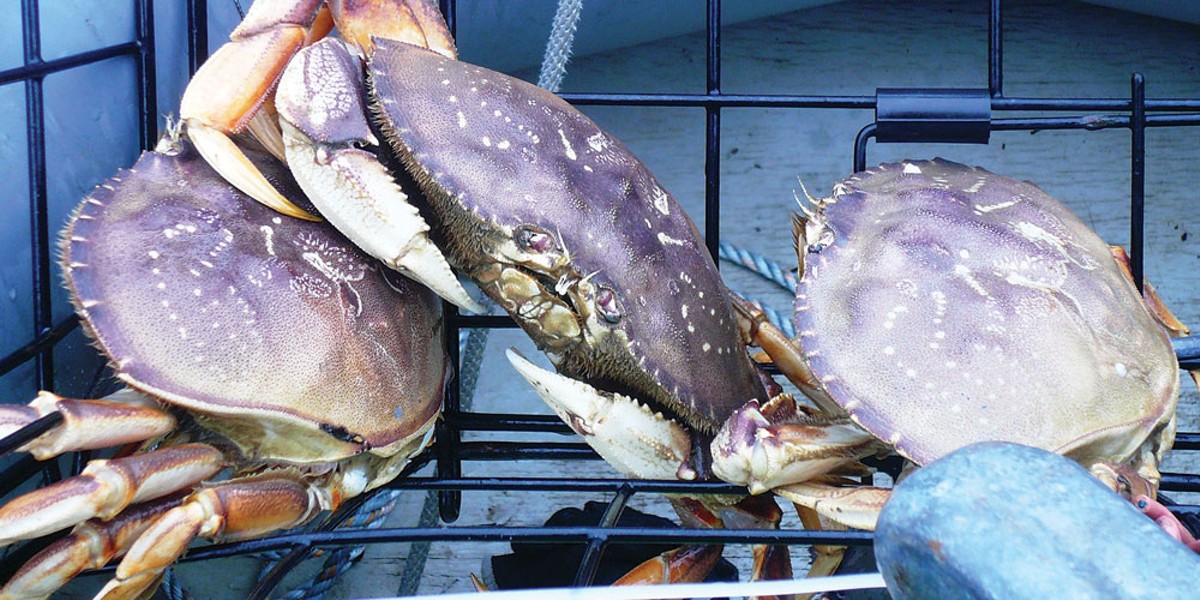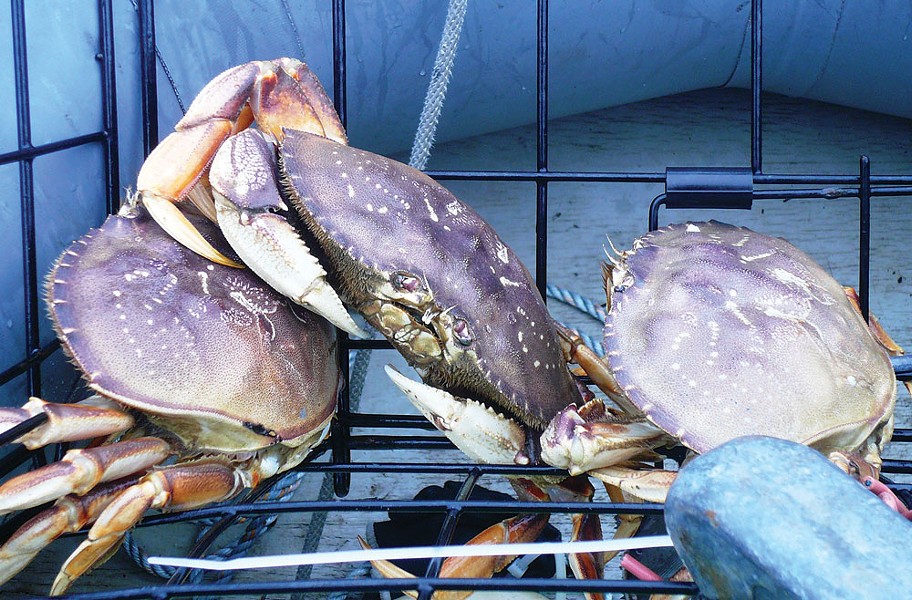Last weekend my dad and I got out for his birthday. We launched our old inflatable boat, powered by a small outboard motor, and took off out of the bay armed with box traps and hoop nets. Our goal was to bring in some of California's tastiest crustaceans — Dungeness crabs. Every year since I was a boy, I would accompany my older brother and my dad out on the boat in search of these crabs. For me, crabbing is part of a tradition that stretches back generations. There is something special about being on the open water, feeling the spray of the sea and taking in all the sights and smells. I cannot tell you how many times we have been accompanied by whales, seals and sea lions — yesterday it was a whole pod of porpoises.
Taj Mahal once sang, "Many fish bites if ya got good bait." This absolutely applies to luring crabs into your traps. Ask the "old salts" of any port city, dock or pier and they will all have opinions on why their particular choice of bait is the best. But all you need is to keep the carcasses after you have removed fillets from your last catch. If you have been too landlocked or busy to get out fishing lately, just ask your local fishmonger if he or she has any fish heads in the back. If you cannot find fish carcasses, a soda-can-sized container with plenty of holes punched in it can be filled with squid and lashed inside (in the center) of your trap. If you don't lash it down and it moves near the trap edge, crabs will sit outside the trap next to the bait and when you bring your gear in you might "get skunked."
One does not necessarily need a powerboat to catch crab. You can take Dungeness successfully from a kayak in calmer waters such as Humboldt and Trinidad bays. However, such a small vessel limits the number of traps you can transport. Anglers can also drop traps off of piers, rock points and jetties. In fact, no fishing license is required when fishing or crabbing on public piers in the ocean or bays. But the general rule of successful anglers is to go where there are fewer people and therefore less fishing and crabbing pressure. This is why hiking, paddling or motoring beyond where most have already cast traps will often result in more plentiful catches. The most important thing to remember is that Dungeness, unlike red rock crabs, prefer a sandy bottom habitat. Find sand/rock interfaces and you will likely find these delicious crabs.
Crab traps come in two main forms, box traps and hoop nets. Both of these are available at local sporting goods and fishing shops, and both have their relative advantages and disadvantages. Lighter hoop nets can be easily thrown from rocks but they are often open on top, which means you need to retrieve them quickly or crabs can climb out as you pull the trap back to the shore or boat. Box traps are far too heavy to throw from the rocks but once a crab enters the trap it is nearly impossible for it to escape.
I cannot overstate how absolutely essential it is to wear a personal floatation device (PFD), aka life jacket, when out on the water. Knowing how to swim even if you only plan to crab from the rocks is also a must. All it takes is one large unseen wave to wash you from the rocks, followed by a significant undertow, and your life could be in serious danger. Additionally, each trap typically has a 75- to 100-foot rope topped with a float so the trap settles on the bottom without submerging the float. If you aren't careful dropping your trap over the edge of your boat, you could easily become tangled, dragged overboard and pulled down. This scenario is potentially deadly, so please heed these warnings.
And now a bit about fishing ethics. It is illegal to pull and check another angler's traps. People do this from time to time and it is sure to result in heavy fines if you are seen by a warden or in a serious fistfight if you are seen by the trap owner. Additionally, sport anglers are allowed 10 crabs per day measuring at least 5 ¾ inches each. Keeping undersized crabs is illegal. The Department of Fish and Wildlife strictly regulates the numbers and size of crabs that can be taken to ensure that enough crabs reach reproductive maturity and subsequent years will have sustainable crab fisheries. Please stay within the limit and throw back undersized crabs — even if it means coming home empty handed.
Crabbers will need a valid fishing license (and I strongly suggest you ask for a free copy of the 2016-2017 ocean fishing regulations and/or visit www.wildlife.ca.gov so you know the rules). You'll also need a crab gauge for measuring. Most gauges will have a point measuring 6 inches, which is the minimum size for commercial fishers, and another measuring 5 ¾ inches for sport anglers like us. Be sure you measure with the correct portion of the gauge or you risk throwing back crabs that are legal for you.
Before going crabbing, always call the California Biotoxin Information line at (800) 553-4133 to be sure crabs are safe to consume. Conditions change, and some years (as was the case last season) elevated levels of natural domoic acid concentrated in crabs made the meat toxic for human consumption. This is due to crabs feeding on marine worms that filter-feed on plankton. All it takes is one freak toxic plankton bloom and crabs can become poisonous to humans. The hotline you will tell you what species are safe to consume and which areas of the state may still be in quarantine. This year, new regulations require that the "Go ID" number (printed on your fishing license) must be written on you crab floats. Another new regulation requires an escape hatch for box traps that is secured with cotton string so that if box traps are lost, the string will rapidly decompose and allow trapped crabs to escape.
Bring a VHF Marine Radio on your boat and know that channel 16 is the emergency channel if you get into a life-threatening situation. Finally, a GPS is not a bad idea for marking your point of entry and your trap locations, especially in heavy fog. But don't rely completely on modern technology as batteries can die. Always keep reference points and landmarks in mind while on the water. Ask yourself where is that buoy in relation to the big rocky point, and what direction is the harbor from there? This can literally save your life. Most importantly, have a great time and enjoy those tasty crustaceans.


Comments (2)
Showing 1-2 of 2